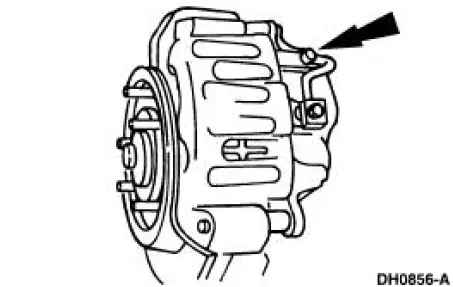Ford Mustang (1999-2004) Service Manual: Caliper
1. NOTE: It is not necessary to do a complete brake system bleed if only the disc brake caliper (2B120) was disconnected.
Place a box end wrench on the disc brake caliper bleeder screw (2208). Attach a rubber drain tube to the disc brake caliper bleeder screw, and submerge the free end of the tube in a container partially filled with clean brake fluid.

2. Have an assistant pump the brake pedal (BP) (2455) and then hold firm pressure on the brake pedal.
3. Loosen the disc brake caliper bleeder screw until a stream of brake fluid comes out. While the assistant maintains pressure on the brake pedal, tighten the disc brake caliper bleeder screw.
- Repeat until clear, bubble-free fluid comes out.
- Refill the brake master cylinder reservoir (2K478) as necessary.
4. Tighten the disc brake caliper bleeder screw. Refer to Specifications.

 Four Wheel Anti-Lock Brake System (4WABS) Hydraulic Control Unit (HCU)
Four Wheel Anti-Lock Brake System (4WABS) Hydraulic Control Unit (HCU)
NOTE: This procedure only needs to be performed if the 4-wheel
anti-lock brake (4WABS) hydraulic
control unit (HCU) has been installed new or if the HCU lines have been
opened.
1. Clean all ...
Other materials:
Dual Converter Y-Pipe - 3.8L
Removal
NOTE: The RH and LH catalytic converters are serviceable separately.
1. Raise and support the vehicle. For additional information, refer to
Section.
2. CAUTION: When repairing the exhaust system or removing exhaust
components,
disconnect all heated o ...
Removal
WARNING: Always wear safety glasses when repairing an air bag
supplemental restraint
system (SRS) vehicle and when handling an air bag module. This will
reduce the risk of injury
in the event of an accidental deployment.
WARNING: Carry a live air ...
Gearshift Rail and Fork
Disassembly and Assembly
1. Using a 5/32-inch drift and a hammer, remove and discard the split pin.
Slide the shift fork from
the shift rail.
2. Remove the gearshift fork inserts.
3. CAUTION: Support the shift rail to prevent damage to the parts.
Positio ...

